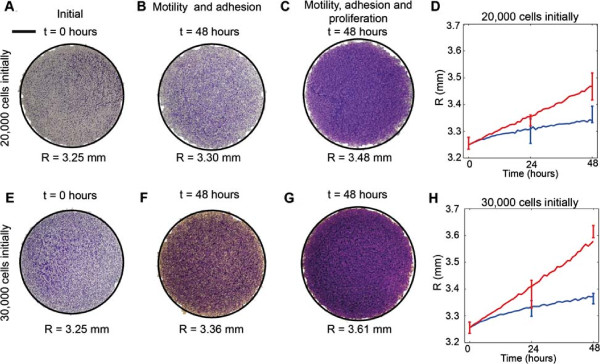Figure 8.

Independent estimates of D, q and λ predict the spatial extent of the expanding colony. Experimental measurements of the radius of the expanding colony were compared to predictions from the parameterised mathematical model using the parameter estimates determined previously. Results in (A–C) and (E–G) compare the position of the leading edge for experiments where 20,000 and 30,000 cells were initially placed inside the barrier, respectively. The scale bar corresponds to 1.5 mm. Images are shown at t=0 hours (A,E), at t=48 hours for the experiments with Mitomycin–C pretreatment (B,F) and at t=48 hours without Mitomycin–C pretreatment (C,G). The solid curves superimposed (black) on each image correspond to the relevant simulation which has been been converted into an equivalent circular area. In all cases, simulation results were averaged over three realisations. Results in (D) and (H) show the mean radius calculated from the experimental images at t=0, 24 and 48 hours, with error bars indicating one standard deviation from the mean. The corresponding average radius of the simulated expanding colony is superimposed in (D) and (H). Blue lines correspond to experiments where proliferation was suppressed using Mitomycin–C pretreatment, while red lines correspond to experiments where proliferation was not suppressed. Simulations were averaged over three identically–prepared realisations. Simulations of the experiments initialised with 20,000 cells correspond to D=162μm2hour−1, q=0.3 and λ=0.0305hour−1, and simulation of the experiments initialised with 30,000 cells correspond to D=243μm2hour−1, q=0.5 and λ=0.0398hour−1.
